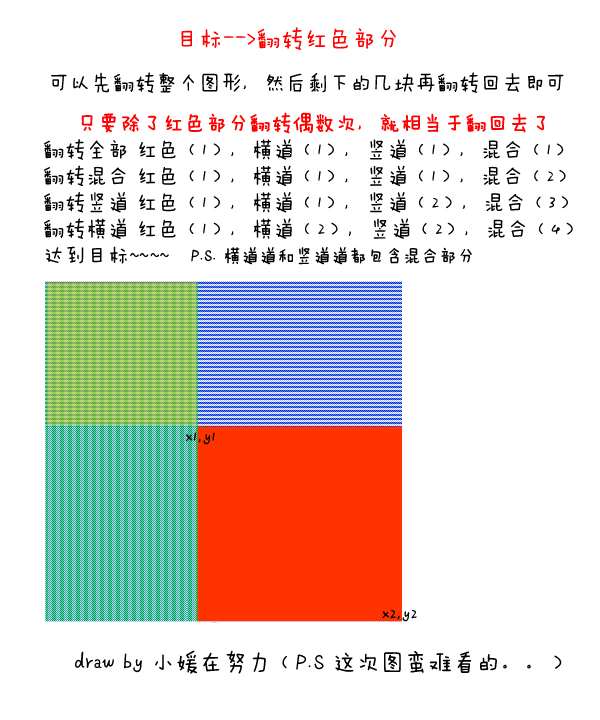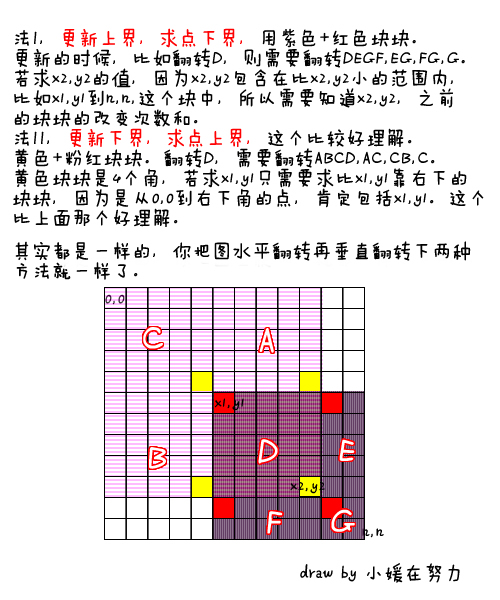poj 2155 Matrix 二维树状数组
来源:互联网 发布:淘宝茶叶店简介怎么写 编辑:程序博客网 时间:2024/06/09 21:40
Description
Given an N*N matrix A, whose elements are either 0 or 1. A[i, j] means the number in the i-th row and j-th column. Initially we have A[i, j] = 0 (1 <= i, j <= N).
We can change the matrix in the following way. Given a rectangle whose upper-left corner is (x1, y1) and lower-right corner is (x2, y2), we change all the elements in the rectangle by using "not" operation (if it is a '0' then change it into '1' otherwise change it into '0'). To maintain the information of the matrix, you are asked to write a program to receive and execute two kinds of instructions.
1. C x1 y1 x2 y2 (1 <= x1 <= x2 <= n, 1 <= y1 <= y2 <= n) changes the matrix by using the rectangle whose upper-left corner is (x1, y1) and lower-right corner is (x2, y2).
2. Q x y (1 <= x, y <= n) querys A[x, y].
We can change the matrix in the following way. Given a rectangle whose upper-left corner is (x1, y1) and lower-right corner is (x2, y2), we change all the elements in the rectangle by using "not" operation (if it is a '0' then change it into '1' otherwise change it into '0'). To maintain the information of the matrix, you are asked to write a program to receive and execute two kinds of instructions.
1. C x1 y1 x2 y2 (1 <= x1 <= x2 <= n, 1 <= y1 <= y2 <= n) changes the matrix by using the rectangle whose upper-left corner is (x1, y1) and lower-right corner is (x2, y2).
2. Q x y (1 <= x, y <= n) querys A[x, y].
Input
The first line of the input is an integer X (X <= 10) representing the number of test cases. The following X blocks each represents a test case.
The first line of each block contains two numbers N and T (2 <= N <= 1000, 1 <= T <= 50000) representing the size of the matrix and the number of the instructions. The following T lines each represents an instruction having the format "Q x y" or "C x1 y1 x2 y2", which has been described above.
The first line of each block contains two numbers N and T (2 <= N <= 1000, 1 <= T <= 50000) representing the size of the matrix and the number of the instructions. The following T lines each represents an instruction having the format "Q x y" or "C x1 y1 x2 y2", which has been described above.
Output
For each querying output one line, which has an integer representing A[x, y].
There is a blank line between every two continuous test cases.
There is a blank line between every two continuous test cases.
Sample Input
12 10C 2 1 2 2Q 2 2C 2 1 2 1Q 1 1C 1 1 2 1C 1 2 1 2C 1 1 2 2Q 1 1C 1 1 2 1Q 2 1
Sample Output
1001
Source
#include<cstdio>#include<string>#include<iostream>#include<string.h>using namespace std;int c[1005][1005],n;int lowbit(int x){ return x&(-x);}void update(int x,int y,int k ){ for(int i=x; i<=n; i+=lowbit(i)) for(int j=y; j<=n; j+=lowbit(j)) { c[i][j]+=k; }}int sum(int x,int y){ int ans=0; for(int i=x; i>0; i-=lowbit(i)) for(int j=y; j>0; j-=lowbit(j)) ans+=c[i][j]; return ans;}int main(){ int t,m,x1,x2,y1,y2; char g[100]; scanf("%d",&t); while(t--) { memset(c,0,sizeof(c)); scanf("%d %d",&n,&m); for(int i=1; i<=m; i++) { scanf("%s",g); if(g[0]=='C') { scanf("%d %d %d %d",&x1,&y1,&x2,&y2); getchar(); update(x1,y1,1); update(x1,y2+1,1); update(x2+1,y1,1); update(x2+1,y2+1,1); } else { scanf("%d %d",&x1,&y1); getchar(); printf("%d\n",sum(x1,y1)%2); } } printf("\n"); } return 0;}今天初步学习树状数组,虽然还有很多不懂,但这也是一个进步吧
下面是转载的一位大牛的博客
楼教主出的二维树状数组。
给出矩阵左上角和右下角坐标,矩阵里的元素 1变0 ,0 变1,然后给出询问,问某个点是多少。
纠结好久了,一直没什么好思路,看discuss说四个角神马的,我搜了下,理解了,树状数组里记录该点的变幻次数,或者直接%2也行。
查询的时候Getsum得到的是该点在所有区间的总变幻次数,最后%2就是结果。
建图的时候死活想不通,杂四个点的坐标是那个 = =。。。刚才协会开会了,在路上想通了,我想的0,0坐标是类似坐标轴的那种,在左下角。。。而矩阵的0 0 应该是在左上角。。这样,什么都通了 = =。。。
还有,更新的时候有的减1了,死循环了,发现错误了,树状数组里是不能使用下标为1的,所以更新的时候把下标都加一即可。
实验了下,%2和&1速度一样。。。
提供坐标的图。。
我见另一种做法,见 http://3214668848.blog.163.com/blog/static/48764919201052484413539/
就是原来的Updata改成Getsum。。。Getsum改成Updata。只不过每个坐标不用++了。

这题我还是有点迷茫的。刚才上机组课想了下,经过我画图以及认真分析(//害羞)代码,终于理解了。。。继续画图先。。

#include <queue>#include <stack>#include <math.h>#include <stdio.h>#include <stdlib.h>#include <iostream>#include <limits.h>#include <string.h>#include <algorithm>using namespace std;const int MAX = 1010;int c[MAX][MAX];int n;int Lowbit(int x){return x & (-x);}void Updata(int x,int y){int i,k;for(i=x; i<=n; i+=Lowbit(i))for(k=y; k<=n; k+=Lowbit(k))c[i][k]++;}int Get(int x,int y){int i,k,sum = 0;for(i=x; i>0; i-=Lowbit(i))for(k=y; k>0; k-=Lowbit(k))sum += c[i][k];return sum;}int main(){int ncases,m;int x1,y1,x2,y2;char ch[2];scanf("%d",&ncases);while( ncases-- ){memset(c,0,sizeof(c));scanf("%d%d",&n,&m);while( m-- ){scanf("%s",ch);if( ch[0] == 'C' ){scanf("%d%d%d%d",&x1,&y1,&x2,&y2);x1++; y1++; x2++; y2++;Updata(x2,y2);Updata(x1-1,y1-1);Updata(x1-1,y2);Updata(x2,y1-1);}else{scanf("%d%d",&x1,&y1);printf("%d/n",Get(x1,y1)%2);}}printf("/n");}return 0;} 0 0
- poj 2155 Matrix(二维树状数组)
- poj -- 2155 Matrix (二维树状数组)
- POJ 2155 Matrix 二维树状数组
- POJ 2155 Matrix(二维树状数组)
- POJ 2155 Matrix ---二维树状数组
- poj 2155 Matrix 二维树状数组
- POJ 2155 Matrix (二维树状数组)
- poj 2155 Matrix (二维树状数组)
- POJ 2155 Matrix(二维树状数组)
- 【树状数组(二维)】poj 2155 Matrix
- POJ-2155 Matrix 二维树状数组
- POJ 2155 Matrix (二维树状数组)
- [poj 2155] Matrix(二维树状数组)
- Matrix - POJ 2155 二维树状数组
- POJ 2155 Matrix 二维树状数组
- POJ 2155 Matrix 【二维树状数组】
- POJ 2155 Matrix (二维树状数组)
- poj 2155 Matrix (二维树状数组)
- js键盘事件
- LeetCode | Same Tree(相等的二叉树)
- 二次提交请带好随机数
- PHP的instanceof关键字
- iOS学习笔记-- 加载图片选择imageNamed 方法还是 imageWithContentsOfFile
- poj 2155 Matrix 二维树状数组
- PHP设计模式之:单例模式
- mysql存储过程详解
- 英语听力提高的最快方法
- XML document structures must start and end within the same entity
- SQL sever 2012 安装教程
- urlrewriter首页设置
- hdu 3584 Cube 三维树状数组更新查找
- Change Number to English By Reading rule of money


